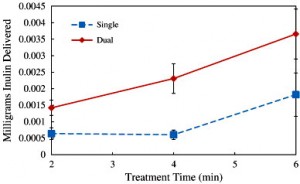Here we are, yet again, discussing BPA and the effects of exposure to the nasty chemical. BPA (bisphenol A) is a chemical which mimics estrogen in the human body. It has been linked to cancer, cardiovascular disease, sterility, diabetes and recently: obesity (Wikipedia, 2012). Not only has the chemical been found to be harmful when ingested, it has also been discovered to have a high dermal absorption coefficient; in other words, it is easily absorbed by the skin. So why is it still being ingested by millions of people and estimated to be present in 93% of us? (Prosolia, 2012)
The Canadian government was the first to recognize BPA as a toxin in 2010 and the United States’ FDA finally followed suit this year and banned the use of the chemical in baby bottles and sippy cups (The New York Times, 2012). Unfortunately, BPA is still being used today as a lining for aluminum cans (Science Daily, 2012). Many companies have recently added the tag ‘BPA free’ to their products to keep consumers buying, but are we really aware of the amount of BPA we ingest daily and how to prevent it? Did you know that the new plastic Canadian bills have the highest BPA levels measured in comparison to 9 other countries’ currencies? Research suggests the BPA content in thermal paper rolls, such as those used to print receipts in retail stores, can be passed onto bills simply by contact (Prosolia, 2012).

The epidemic of obesity in children and adolescents, and its potential causes, has been widely talked about but it has not yet been tied to a specific environmental chemical. A recent study has made history by being the first to use a nation-wide sample of children and adolescents to observe a correlation, if any, of BPA with obesity. The sample size was 3000 children and adolescents between the ages of 6 and 19. The participants were randomly selected to have urine analysis of BPA concentration in order to find any correlation between their BPA levels and obesity. The significant finding: white children and adolescents with high BPA concentrations in their urine were 2.6 times more likely to be obese over those with low BPA concentrations. According to researchers, these results are significant enough to show a correlation between BPA levels and obesity, but the direct process of how the chemical may affect obesity, if in fact it does, is not known. The study was well controlled, making sure to account for everything from caloric intake to the chance of other phenols, such as soaps and sunscreens, being the cause for correlation. The researchers suggest that the best way to limit BPA exposure in children would be to eliminate it from aluminum cans (Science Daily, 2012).

http://www.calgaryherald.com/life/Study+finds+connection+between+cans+bottles+childhood+obesity/7259888/story.html (accessed September 18, 2012)
Whether BPA attributes to obesity or not, there has been enough research done to show its harmful effects. Why isn’t it banned from all products used in food production? Or banned completely due to its ability to be absorbed so easily by the skin? I am proud of Canada for being the first nation to recognize BPA as a toxin and to eliminate it from baby products, but why is it still being fed to children, adolescents and adults? So much more needs to be done.
-Kady McCappin
Sources:
Science Daily. “Higher Levels of BPA in Children and Teens Significantly Associated With Obesity.” http://www.sciencedaily.com/releases/2012/09/120918111125.htm (accessed September 18, 2012)
The New York Times. “F.D.A. Makes It Official: BPA Can’t Be Used in Baby Bottles and Cups.” http://www.nytimes.com/2012/07/18/science/fda-bans-bpa-from-baby-bottles-and-sippy-cups.html?_r=0 (accessed September 18, 2012)
Wikipedia. “Bisphenol A.” http://en.wikipedia.org/wiki/Bisphenol_A#Canada (accessed September 18, 2012)
Youtube. “Uncovering Bisphenol A – Covert Depopulation.” https://www.youtube.com/watch?v=tFPXxSmLZgE&feature=related (accessed September 18, 2012)
Prosolia. BPA In Currencies:
- Chunyang Liao and Kurunthachalam Kannan, High Levels of Bisphenol A in Paper Currencies from Several Countries, and Implications for Dermal Exposure , 2011, Environ. Sci. Technol. In press.
- Wolfgang Volkel, Nataly Bittner, and Wolfgang Dekant, Quantation of Bisphenol A and Bisphenol A Glucuronide in biological samples by High Performance Liquid Chromatography-Tandem Mass Spectrometry, Drug metabolism and Disposition, 2005, 33:1748–1757.








